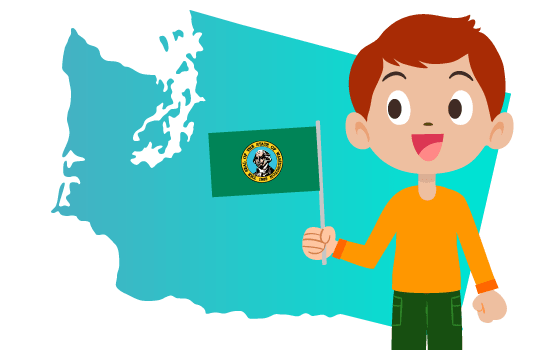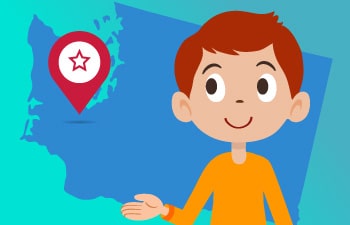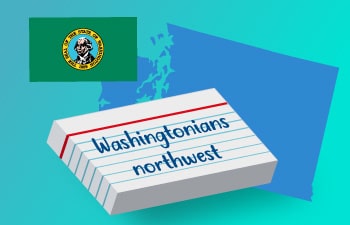Washington state is located in the Pacific Northwest United States and contains the northwestern most point of the continental US, Cape Flattery. Because of its coastline and harbors, Washington is important to trade with the state of Alaska, Canada, and other countries in the Pacific Rim, and it has developed an economy largely based on tourism.
It is also known for its two major technology companies, Microsoft and Amazon, and has become a major player in technology manufacturing. It is home to Boeing’s Everett airplane/jet factory, the largest building by volume in the world, and Seattle’s Evergreen Point Floating Bridge is the longest floating bridge in the world. It is where Starbucks was founded and where Pictionary, Cranium, and Pickleball were invented. Washington is a state containing over 7 million people, mostly living in northwestern areas around the inlet of Puget Sound. The islands of Puget Sound are serviced by the largest ferry fleet in the US, and one of the largest in the entire world.
In this article you’ll learn interesting facts about Washington state, including a Washington state history timeline, geography facts and more. Time4Learning members can download our list of PreK-12 interactive activities that align with your study of Washington.
Washington State Fast Facts
|
Became a State: |
November 11, 1889 |
|---|---|
|
Order it Joined the Union: |
42nd state |
|
State Capital: |
Olympia |
|
State Abbreviation: |
WA |
|
Border States: |
|
|
State Flag: |
|
|
State Song: |
|
|
State Flower: |
Coast Rhododendron |
|
State Nickname: |
Evergreen State, Chinook State |
|
Notable Washingtonians: |
|
Historical Facts About Washington State
Often confused with our nation’s capital, Washington DC, Washington state is over 2,500 miles away. It is the only state named for a US president and has the only state flag showing the image of an actual person, our first president.
Two distinct Native American cultures, the Northwest Coast Indians and the Plateau Indians, are the foundation of Washington’s people. Settlers came to Washington beginning in the 1830s from New England and the Midwest, traveling along the Oregon Trail. They discovered the Nez Percé, Chinook, Coast Salish, and Yakima Native American tribes. Missions were established to convert the Native Americans to Roman Catholic and Protestant religions, also bringing knowledge and material goods to the Native Americans.
In the 1880s, when railroads linked Puget Sound and the Columbia River to California and the East, the population of Washington grew to five times its original number. Conflicts arose, and most Native Americans in the region were moved to reservations. Washington became our 42nd state in November of 1889. In creating their state’s government, Washington’s people demonstrated their distrust of government by limiting state powers. Washington’s history has continued to reflect its political involvement and progressive ideas as it has attempted to address the problems of the modern urban world.
Washington’s history combines the influences of its Native American cultures, its pioneer tradition, and its technological industries. This is evident through Native American art, writings, and films and in outdoor events like rodeos, pioneer festivals, agricultural fairs, and air shows. From Bing Crosby’s role as an American crooner to Ray Charles’ rhythm-and-blues influence when he came to Seattle in the 1950’s, Washington has played a major role in the music industry. It was the birthplace of rock icon, Jimi Hendrix, and had a major role in the grunge scene in the 1990s. Washington’s cultural influences in art and music have continued to this day.
Read the Washington state history timeline below to learn important Washington state history facts through the events that occurred in this state.
1775
Spanish Captain Don Bruno de Heceta explored the coast of Washington on the Santiago, along with a second ship called the Sonora1778
Captain James Cook jumpstarted exploration and the maritime fur trade after a large “catch” of sea otter skins1792
Britain sent George Vancouver to find the Northwest Passage and map the coastline1792
Robert Gray, an American trader, discovered the Columbia River1805
Lewis and Clark entered Washington to begin exploration1812
By this time, US dominated the fur trade1836
Marcus Whitman and Henry Harmon Spalding began a medical mission in southeastern Washington1838
Pierre-Jean de Smet founded his first Christian peacekeeping mission near Council Bluffs1846
US and Britain agreed on the 49th parallel as the boundary between the US and Canada; first permanent settlers founded New Market (now Tumwater)1848
US established the Oregon Territory, including all of Washington, Oregon, and Idaho along with parts of Montana and Wyoming1853
Congress created the Washington Territory, which included parts of Idaho and Montana1889
Washington was added to the union as the 42nd state1909
Alaska-Yukon-Pacific Exposition was held in Seattle to celebrate the gold discoveries and trade1911
Work began on the Bonneville and Grand Coulee dams, eventual sites of hydroelectric power plants1943
Hanford Works atomic energy plant opened, eventually building many of the US atomic bombs1962
Washington’s prosperity was celebrated at the Seattle World’s Fair, also known as the Century 21 Exposition1976
Dixie Lee Ray became one of the country’s first women governors (only the second to be elected not simply to succeed a husband)1980
Mount Saint Helens erupted1996
Human remains, known as “Kennewick Man,” were discovered near Kennewick, WA, and dated to be around 9,400 years old (known as the “Ancient One” by Native Americans)1999
Demonstration at the World Trade Organization meeting in Seattle against environmental and economic effects of globalization (international expansion of business)Bring history and geography to life with Time4Learning’s interactive online social studies curriculum for grades 2-12.
Geographical Facts About Washington State
Washington’s geography splits the state, essentially, into two parts. The western third is rainy, so industries focus on forests, fisheries, agriculture, and imported raw materials. The eastern two-thirds, in the rain shadow of the Cascade Range, is drier with mostly agricultural industries targeting livestock, wheat production, and irrigated crops (using channels to supply water to the crops).
Washington is the largest producer of apples in the US. It is a state that is marked by rainforests (the only ones in the continental US), forests, highlands, lowlands, river floodplains, and mountain ranges with permanent glaciers (the most glaciers in the continental US) located at the highest peaks of the Cascades. Its geography enables a variety of wildlife including elk, bear, mountain goat, puma and a number of waterfowl. Washington is also inhabited by trout, sturgeon, and bass in its freshwaters and salmon and shellfish along its Pacific shorelines and streams. Killer whales, and also gray and humpback whales, can be found in northwestern Washington. Water remains the state’s most valuable natural resource.
Check out this map of Washington to start getting familiar with the state. Then read through the following Washington geography facts. Print out the map of Washington provided below and add these items to the map.
- Washington is bordered by the Canadian province of British Columbia in the north, the state of Idaho in the east, the Pacific Ocean in the west, and the state of Oregon in the south.
- The Puget Sound is an inlet of the Pacific Ocean in the northwestern corner of the state that extends from the Strait of Juan de Fuca and is joined by the Strait of Georgia (which extends into Canada).
- The capital of Washington, Olympia, lies in the western part of the state at the southern part of Puget Sound.
- In the northwest region of Washington are the Olympic Mountains, including Mount Olympus at 7,965 feet. Rainforests lie along the western slopes of these mountains.
- Coastal ranges can be found along the southwestern shores of Washington.
- The Cascade Range extends north to south/southwest along the western middle of the state.
- Mount Rainier, the fifth highest peak in the continental US, is part of the Cascades and reaches 14,410 feet.
- Mount St. Helens, site of the 1980 volcanic eruption, is located in the Cascades near the Oregon border.
- The Columbia River, the largest river flowing from North America into the Pacific Ocean, flows southwest diagonally across the state.
- In the northeast are the Okanogan Highlands, north-south ranges that are extensions of the Rocky Mountains and contain most of Washington’s metallic ores (magnesite, lead, and zinc).
Washington State Map
Download our FREE Washington state map printable. Use it as a coloring page or use it to plot the state’s geographical features.
Activities for Children in Washington
How else can you discover fun facts about Washington state? Visiting Washington will allow you to experience both its breathtaking scenery and its unique culture. Homeschoolers in Washington can plan engaging day trips while visitors may be able to schedule extended visits to some of the state’s fascinating places. Here are some possibilities:
- Museum of Pop Culture (Seattle): Founded by Microsoft co-founder, Paul Allen, this nonprofit museum showcases artifacts from icons of American culture. You can register for individual homeschool days or get a season pass for annual access to all Homeschool Day programs.
- North Cascades National Park (Sedro-Woolley): Three hours from Seattle, this national park includes jagged peaks, over 300 glaciers, waterfalls, and more than 500 lakes and ponds. You can go hiking, river rafting, horseback riding, boating, fishing, and camping, or take a flight on a seaplane.
- Olympic National Park (Port Angeles): Explore three parks in one: 1) mountains with snow, glaciers, seasonal wildflowers, and wilderness, 2) Hoh Rainforest, which is home to elk, black bears and other wildlife, and 3) over 70 miles of coastline with beaches, tide pools and sea stacks. Enjoy boating, camping, fishing, hiking, tidepooling, and seasonal activities. There are also plenty of animals to see, and the park hosts ranger-led programs and night sky programs. Children aged four and up can participate in the Olympic National Park Ocean Stewards Program, and all members of the family can join in the National Parks Passport Program.
- Pike Place Market (Seattle): Discover the foods, crafts, and unique shops within this nine-acre historic district. See the famous flying fish as people purchase their meals at the Pike Place Fish Market, and visit Rachel, the 550-pound bronze piggy bank. After enjoying all of the oddities and treats at the market, find the famous Gum Wall in Lower Post Alley.
Looking for more things to do with your kids in Washington? Check out this post full of field trip ideas in Washington!
Washington State Freebies and Deals for Homeschoolers
You can learn more Washington state facts and information without spending a lot of money. There are plenty of low-cost opportunities and fee free days. Below are just a few:
- Bainbridge Island Museum of Art (Bainbridge Island): This is a free museum that shares the art and crafts of the Puget Sound region. On Saturdays, take advantage of free make-and-take art project workshops guided by teaching artists.
- Bug and Reptile Museum (Bremerton): Enjoy 15 kid-friendly exhibits where you see live bugs and reptiles, look at bugs under a microscope, experience the world through the eyes of a bug, and view an 8-foot long ant farm. Admission is free.
- Center for Wooden Boats (Seattle and Camano Island): This is a free, living museum that showcases the history of wooden boats and engages visitors through exhibits, photography, and hands-on experiences. There are free public sails on Sundays, free boat building workshops for kids and adults on Thursdays (Seattle) and Saturdays (Cama Beach), and a free speaker series on the third Friday of every month.
- Grand Coulee Dam (Coulee Dam): See the largest capacity hydropower project in the US, and the fourth largest in the world, producing almost $2 billion dollars in benefits per year. Explore the visitor center and then stay for a free laser light show in the evening.
- Museum of Flight (Seattle): Visit the largest non-profit air and space museum in the world. Experience being a pilot or training for flight in a space shuttle. Tour the famous Boeing Field and view 3-D movies about aviation and spaceflight. Fly like a bird or design your own aircraft. If you cannot visit the museum in person, access the virtual museum online. Take advantage of camps and STEM-based programs, or visit the museum on Saturdays or Sundays for Weekend Family Workshops (free with the cost of admission). Thanks to the sponsorship of Wells Fargo, you can visit the museum on the first Thursday of the month from 5-9 p.m. for free.
Washington State Learning Games for Children
Test your Washington facts knowledge with these free games and activities:












